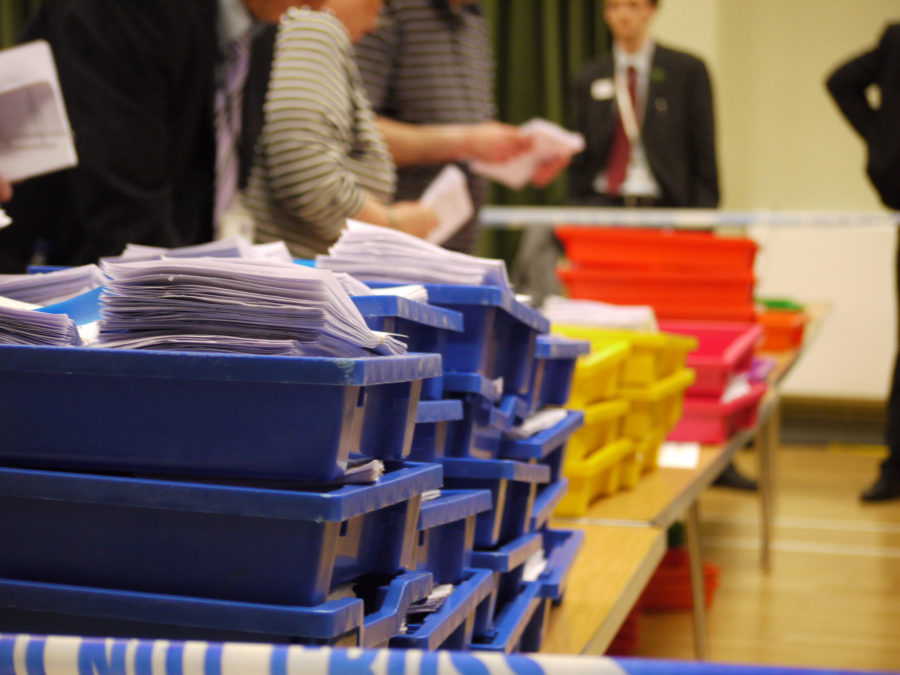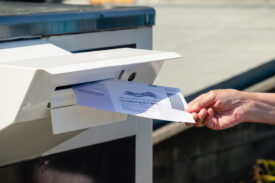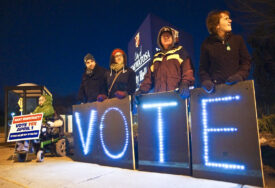Cascadian reformers are hoping to spread the use of Ranked-Choice Voting (RCV) from its regional foothold in Benton County, Oregon, to elect executives and legislatures across the region. State law in both Washington and Oregon dictates electoral methods for non-charter, a.k.a. “code,” counties and cities. But charter counties and cities in Oregon have a large amount of autonomy, and in Washington some autonomy, to amend their charters and improve local electoral methods. However, outdated voting equipment unable to process ranked ballots can be a roadblock to adopting RCV.
Voting equipment is typically purchased and managed at the county level, and some Northwest counties already have equipment that can tally ranked ballots, or could with a small upgrade—these places are ripe for RCV advocacy. For counties with outdated equipment, the easiest course of action is to simply choose ranked-choice-ready equipment when they are purchasing new equipment anyway. Or, they could ask a neighboring county with ranked-choice-ready equipment to tally their ranked ballots for them.
Adopting RCV election methods and acquiring RCV-ready equipment are like the proverbial chicken-and-egg: counties may not choose RCV-ready equipment if no elections in their jurisdiction use RCV elections, but voters might be reluctant to switch to RCV elections if their voting equipment cannot count ranked ballots. This article, a complement to our review of the legal barriers to ranked-choice voting in Oregon and Washington, identifies places in these two states where adopting RCV would be easy and timely both in terms of required equipment upgrade (if any) and policy changes.
- First, we briefly review Oregon and Washington state law limitations on cities and counties wishing to adopt RCV.
- Next, we describe voting equipment options and costs and the current equipment in Oregon and Washington.
- Then we identify advocacy priorities in Oregon and in Washington.
- Finally, we include an appendix detailing equipment currently in use in each county in Oregon and Washington and how it stacks up on ranked-choice-readiness.
Sightline supports other electoral reforms in addition to RCV, including Mixed Member Proportional (MMP) to elect state legislators and Score Runoff Voting (SRV) for executive races. This report only covers RCV-readiness because existing equipment could already count an MMP ballot, and we could not find any existing systems or software packages that can count SRV ballots.
In summary, we see the following categories of counties as high priorities for RCV advocacy:
1. Counties using Clear Ballot voting equipment
Six Oregon charter counties (Hood River, Jackson, Josephine, Lane, Multnomah, and Washington) and five non-charter counties (Coos, Deschutes, Harney, Klamath, and Linn) use Clear Ballot voting equipment. So do two Washington charter counties (King and Pierce). Clear Ballot seems to be a system of choice for counties replacing their equipment—of the 22 Oregon and Washington counties that have purchased new equipment in the past three years, 13 have chosen Clear Ballot.
Clear Ballot hardware can handle RCV ballots, but unfortunately, its software cannot. However, Clear Ballot appears eager to write an RCV software module, if a client requested it. If even one Clear Ballot county, or possibly a city within one of the counties, adopted RCV and asked Clear Ballot to write a software update module, all thirteen would quickly become ranked-choice-capable. King County, Washington, in particular could be a target for advocates because it is a large charter county with a charter review process coming up; if it adopted RCV, it could negotiate with Clear Ballot to write the software module.
2. Counties that are already ranked-choice-ready
“Ranked-choice-ready” (RCV-ready) equipment can internally count ranked-choice ballots for either Instant Runoff Voting (IRV) or Single Transferable Vote (STV). Two Oregon non-charter counties (Clackamas and Marion) and five Washington non-charter counties (Chelan, Douglas, Island, Kittitas, Skagit) have RCV-ready equipment. Unfortunately, elections in code counties are governed by state law, so none of these non-charter counties could adopt RCV itself, but advocates could urge charter cities within Clackamas and Marion counties—for example, Lake Oswego and Salem—to adopt ranked-choice election methods with no equipment barriers. None of the Washington counties contains any charter cities, so there are no local reform opportunities there (although the RCV-ready counties could help other counties count ballots and could help count statewide elections, as we discuss more below).
3. Counties that are already ranked-choice-capable
“Ranked-choice-capable” (RCV-capable) equipment can tally ranked-choice ballots with additional software support, either by adding a software module available from the manufacturer or by using third-party software. Two Oregon charter counties (Benton and Clatsop) and four Oregon non-charter counties (Columbia, Lincoln, Polk, and Tillamook) are RCV-capable. All six of them use the same equipment from ES&S, and one of them, Benton County, is already planning to acquire third-party software to implement the countywide RCV initiative voters approved last year. Once the county purchases this software, any charter city within Benton, such as Corvallis, could adopt RCV for municipal elections and have immediate access to RCV-ready equipment.
Advocates could encourage the other five Oregon counties with the same equipment as Benton to purchase the software in bulk along with Benton and potentially negotiate a better deal with the manufacturer. Then the counties, and all charter cities within these six RCV-capable Oregon counties, would be ready to tally ranked ballots.
Two Washington charter counties (Snohomish and Whatcom) and one Washington non-charter county (Franklin) are RCV-capable, via a software upgrade available from the manufacturer, Dominion. There are no charter cities in Franklin. Advocates could encourage Snohomish and Whatcom counties and any charter cities within them, such as Bellingham and Everett, to adopt RCV and prompt the county to purchase the necessary software upgrade.
4. Counties already planning to replace their equipment
Approximately 17 Oregon counties and 26 Washington counties have equipment close to or more than a decade old and nearing the end of its useful life, so they may soon be turning over equipment. Advocates could urge them to choose ranked-choice-ready equipment and not lock themselves into another decade of inflexibility.
Douglas and Yamhill counties in Oregon have indicated plans to replace equipment in the near future. Though these non-charter counties cannot themselves adopt RCV, charter cities within them, such as Sutherlin and McMinnville, could. If charter cities adopted RCV, then ranked-choice capability would be a requirement of the county’s new system. Or, if advocates convinced the counties to purchase RCV-ready equipment, these cities would be ripe for election reform.
Clallam, Clark, Whatcom, and San Juan, charter counties in Washington, have indicated to us that they plan to purchase new voting equipment in the next three to five years. If they adopted RCV, then ranked-choice capability would need to be a requirement of the new system. Or, if advocates convinced them to purchase RCV-ready equipment, they would be ripe for election reform.
Oregon state law limitations on city and county adoption of ranked-choice voting
In Oregon, the constitution specifically allows ranked-choice voting and proportional representation. The constitution also gives charter cities and towns total authority over the “structural and organizational arrangements” of local government. Indeed, the Advisory Commission on Intergovernmental Relations ranks Oregon number one in the United States for county home rule authority and number six for city home rule authority. Oregon has nine home rule (charter) counties and more than one hundred charter cities—all of these could amend their charters to adopt ranked-choice voting.
Oregon’s 27 non-charter, a.k.a. “code,” counties and more than 100 code cities are governed by state law. State law requires primaries and may require plurality voting. The only way for code counties and cities to adopt ranked-choice voting would be for the state legislature to change the law and instead require code cities and counties to use ranked-choice voting, which is unfortunately unlikely. However, charter cities within code counties could amend their charters and use RCV.
Washington state law limitations on city and county adoption of ranked-choice voting
In Washington, unfortunately, state law limits cities’ and counties’ RCV options. As in Oregon, code counties and cities must follow state law governing elections, so they could only adopt RCV if the legislature changed the law. Only nonpartisan charter counties—King, Whatcom, and San Juan—may choose to adopt single-winner RCV, a.k.a. Instant Runoff Voting (IRV). Partisan charter counties—Clallam, Snohomish, Pierce, and Clark—could choose to adopt IRV if they also made their races non-partisan. Otherwise, state top-two law applies, and there is no point in ranking just two candidates.
At the municipal level, charter cities may only adopt single-winner IRV if they retain primary elections. Top-two does not apply to cities and towns, but state law does require cities and towns to hold primaries, so a charter city could adopt a top-three or top-four primary with IRV in the general election. State law also likely prohibits any local Washington jurisdiction from adopting multi-winner RCV, a.k.a. Single Transferable Vote (STV), because it requires cities and counties to number positions with the same name or district and deal with them as “separate offices for all election purposes.”
Voting equipment
Counties purchase and manage voting equipment, but they may only use equipment that has been certified by the Secretary of State. Counties usually purchase new equipment roughly every ten years. They may use their own funds to do so or apply for state or federal funds. Counties have several options for gaining access to RCV-ready or -capable equipment, and the right option will depend on the county’s budget, size, and options related to its existing equipment.
Certified systems in Oregon and Washington
Counties may only use systems that the state’s Secretary of State has certified.
The Oregon Secretary of State has certified systems from three major voting equipment manufacturers: Clear Ballot Group, Election Systems and Software (ES&S), and Hart Intercivic. The Washington Secretary of State has certified systems from those three manufacturers plus one more: Dominion. Of these vendors:
- Two have system options that can process and tally ranked-choice ballots internally: Dominion’s Democracy Suite system and Hart’s Verity 2.0 system. While no Northwest counties use Dominion’s Democracy Suite at this time, two Oregon counties and five Washington counties will be using Hart’s Verity 2.0 by the end of 2017.
- Dominion’s Optech system can utilize a company-manufactured RCV software module to process RCV ballots. Three Washington counties use this system and could purchase the software module without changing their hardware.
- ES&S’s DS850 high-speed scanner, when paired with ES&S’s Electionware software, can produce a cast vote record (CVR) which can then be exported to third-party software for vote tabulation. Six counties in Oregon currently have the CVR-capable software/hardware combination.
- ES&S’s DS850 high-speed scanner, when paired with an older software system called Unity 3.4, cannot produce a CVR, but the county could purchase the company’s new Electionware package and become ranked-choice-capable via the CVR and third-party software solution. The cost for this software would depend on the county’s contract and annual license agreement, but it would almost certainly be lower than the cost of new hardware. Three Washington counties have DS850 scanners with Unity 3.4 software.
- Finally, the Clear Ballot Group is a relatively new voting equipment vendor, and the company has indicated great willingness to work with an interested county to write a RCV software module that would make its system ranked-choice-capable. Eleven Oregon counties and two counties in Washington will be using the Clear Ballot system by year’s end.
- All other certified systems are not ranked-choice-capable either internally or via third-party software. These include a) the ES&S Unity system paired with M650 scanners, used by 15 Oregon counties and 5 Washington counties, and b) Hart’s HVS system, in use in 2 Oregon counties and 21 Washington counties.
Of the systems that are RCV-capable, most can tabulate a multi-winner RCV race—a Single Transferable Vote (STV) election—via a particular software configuration. Counties interested in running STV elections will likely need to request this option from their equipment manufacturers or the third-party software developer with which they work.
The following table summarizes this information.
- Bright green indicates systems that are internally ranked-choice-ready and could process a ranked-choice election immediately.
- Light green systems are ranked-choice-capable: they have the potential to process a ranked-choice election with an upgrade to their current software or by using third-party software.
- Yellow systems could process a ranked-choice election by purchasing new (but already developed) software from their current manufacturer, or by asking their current manufacturer to develop new software.
- Red systems cannot process ranked-choice Counties with these systems would need to upgrade both their hardware and software components to become ranked-choice capable, or else send their ballots to another county for processing.

Original Sightline Institute graphic, available under our free use policy.
* These columns list the counties that will be using this system by the end of 2017; a few counties are currently undergoing equipment transitions (King, WA; Hood River, OR) and are included in row of the system they are upgrading to.
Counties could choose RCV-ready when replacing equipment
The cheapest and easiest route to RCV-readiness is for counties to simply choose RCV-ready equipment when they are replacing old equipment anyway. Advocates could target the counties that are preparing to purchase new equipment to make sure they choose well. To support this plan of action, the Secretary of State could issue a directive requiring that, when counties purchase new equipment, it must be RCV-ready equipment. Or, if the Secretary of State offers funds to help counties upgrade their equipment, the Secretary could only make the funds available to counties purchasing RCV-ready equipment. This could have been enacted in Washington state this year had the legislature approved the nearly $6 million Governor Inslee proposed for upgrading voting equipment across the state (see page 43). Unfortunately the legislature axed this from the final approved budget.
Many counties in Oregon and Washington purchased their current voting equipment in the early 2000s when there was some federal money available. Since then, relatively few counties have upgraded their equipment, leaving many of Cascadia’s US counties with vote-counting equipment that will likely need to be updated soon. Several Oregon counties have already begun the replacement process: 13 of Oregon’s 36 counties have replaced their equipment since 2015, largely without the help of any federal or state funds.
So far, Washington counties have been slower to replace: only 3 of the state’s 39 counties have replaced their equipment in the last two years, though 6 more are on the verge of doing so.
Counties could share equipment
Counties might not need to own RCV-ready equipment to conduct an RCV election. Counties could share equipment or even jointly purchase it. Auditors or clerks from smaller, or non-RCV-capable counties could transport ballots for counting to nearby counties that have the necessary equipment and pay them an administrative fee to tally the ballots. Eight Oregon counties and eight Washington counties are already RCV-ready or RCV-capable, and if the thirteen counties using Clear Ballot—including Multnomah and King, the largest counties in Oregon and Washington—became RCV-ready, together they might have the capacity to count an RCV election for any county in the state, or even for a statewide election.
Equipment upgrades are relatively affordable
Vote-counting systems typically consist of hardware—a ballot scanner slightly larger than an office printer—and software—a system for tallying the votes, usually bundled with the hardware. Since both Oregon and Washington vote by mail, voters mail their ballots to a central location in their home county, and the county scans and counts them, making equipment needs simpler. (In contrast, states with physical polling locations must also purchase smaller polling-place equipment and scanners, plus counting software for each precinct. Then, each precinct counts its votes and transmits totals to a central location.)
Most counties in Oregon and Washington have between 2 and 10 scanners, depending on a host of factors including the scanner type, software package, and population of the county. New scanners cost in the ballpark of $60-110,000. Software packages and update modules are usually less costly but quite variable, ranging from potentially free for a small upgrade to around $25,000 for a new module, to as much as $200,000 for a whole new software system. Counties update their software to newly released versions semi-regularly, and the costs of the updates, if any, would be subject to the contract negotiated with the vendor. Free third-party software for counting ranked ballots from some systems may soon be federally certified and available from the Ranked Choice Voting Resource Center.
Equipment upgrade and replacement costs
As mentioned above, county equipment can fall into a number of categories of RCV-readiness. Although pricing depends on each county’s specific situation, equipment upgrades fall into a few rough price ranges:
- RCV-ready: the county’s vote-counting equipment can process and tally these ballots internally. These counties are ready to go, with no further equipment or software expenditures.
- RCV-capable: the county’s vote-counting equipment can process and tally RCV ballots with a software upgrade:
- Dominion has an add-on software module that works with the Optech 400C-3 scanner and WinEDS software. The three Washington counties with this system can keep their scanners and software and purchase the add-on software module from the manufacturer. This might cost a county on the order of $20,000. Or they might be able to use third-party software that may be available for free later this year from the Ranked Choice Voting Resource Center, so these counties may also be able to count ranked ballots with no further expenditures.
- Six Oregon counties have EVS (ES&S DS850 scanners and Electionware software) that can read ranked-choice ballots and produce a cast vote record (CVR). The county can use third-party software to tally the CVRs. Third-party software costs in the neighborhood of $20-$25,000. Certified third-party software maybe available for free later this year from the Ranked Choice Voting Resource Center, so these counties may also be able to count ranked ballots with no further expenditures.
- Three Oregon counties have ES&S DS850 scanners but use the company’s older Unity software system. These counties could purchase Electionware software from the manufacturer to produce a CVR and then use third-party software to tally ranked ballots. Upgrading from Unity to Electionware might cost the county on the order of $25,000, plus another $20-$25,000 for third-party software, unless the county can get it for free from the Ranked Choice Voting Resource Center.
- RCV potential: Eleven Oregon counties and two Washington counties use Clear Ballot equipment. Clear Ballot scanners can read a ranked ballot, but its software can’t count it. If Clear Ballot wrote a software upgrade module that could internally tally ranked ballots, any county using Clear Ballot could purchase the software module and immediately be RCV-ready. If multiple counties negotiated with Clear Ballot at once, it might reduce the cost per county. Pricing information is hard to find, but we believe this might cost each county on the order of $20,000.
- Not RCV-capable: The 17 Oregon counties and 26 Washington counties with neither hardware nor software that is compatible with any of the above options could share equipment with neighboring RCV-ready or -capable counties and pay only fees associated with this equipment use. Or they could acquire new equipment—scanner and software—that is RCV-ready. New equipment might cost between $85,000 and $530,000, depending on the size of the county.
Add it all up, and for less than $4.5 million, a generous estimate, every county in Oregon could have RCV-ready or RCV-capable equipment. That’s 0.01 percent of the state’s annual budget. And again, many counties will have to incur the cost of upgrading equipment soon anyway, so becoming RCV-ready could be an added bonus, not an added cost. In the meantime, not every county needs to be RCV-ready to run an RCV election, because non-ready counties could ask for help from ready counties.
Similarly in Washington, all counties could have RCV-ready or -capable equipment for a total cost of less than $9 million, equivalent to less than 0.02 percent of the state’s annual budget. In the context of a single county’s budget, even the most expensive option—replacing a county’s entire voting equipment system, including scanners and software—is equivalent to 0.1 percent of Clark County’s annual budget, or less than the cost of a roof replacement project (page 52) or road sweeper (page 103).
The Accessibility Voting Unit (AVU) provided at election centers for people with disabilities must also support ranked ballots. Counties usually purchase AVUs from the manufacturer at the same time they purchase new scanners and software. We’ve included estimates for the cost of AVU equipment in each county in our cost estimates, but our charts detailing voting equipment options do not include information about AVUs.
Data transmission
Ranked-choice elections at the local level (e.g., county-, municipal-, or district-level elections) do not introduce any added complexity with regards to information transmission during the counting process since Oregon and Washington voters mail their ballots to a central tallying location within each county anyway.
Statewide races present a greater challenge, though, since RCV races must be centrally tabulated when the race is not decided in the first round. The state would need to develop procedures for counting subsequent rounds. County auditors could transmit round one totals (first-choice totals) to the Secretary of State (SOS). The SOS could then tell all counties the lowest candidate(s) to eliminate and recount the second-choice votes on those ballots. Each county would then transfer the votes and send the next round of top-choice totals to SOS. This process would repeat until a winner is decided. Alternatively, counties could transmit “digital vote records” to the state, which are electronic cards with memory chips that contain all scanned ballot information, and then the state would do the entire tabulation.
Priority actions to move RCV in the Pacific Northwest
Democracy advocates in Oregon and Washington have several ripe opportunities for growing the usage of ranked-choice voting in the region. Below, we list opportunities to take steps towards RCV in Oregon and Washington counties in order of ease of implementation, including both voting equipment and policy considerations.
Oregon
We see the greatest opportunities for progress toward RCV in 22 of Oregon’s 36 counties. In many cases, a small change in equipment could make it possible to utilize ranked-choice voting for elections in these counties in the near future. In other cases, counties are a few steps away from being able to adopt RCV, but all have clear paths forward. The table below lists these opportunities in order of priority, based on those easiest to achieve and most influential, to those most difficult to achieve or with least immediate impact.
As stated above, all charter counties and cities in Oregon can amend their charter and implement either IRV or STV.
The counties are listed roughly in order of opportunity, with the shortest-term opportunities at the top in the darkest green , and the longer term opportunities at the bottom in lightest green.

Original Sightline Institute graphic, available under our free use policy.
Washington
Of Washington’s 39 counties, we see easy steps forward in 18. As in Oregon, some of these steps lead immediately to utilizing ranked-choice voting while others are one of a few steps. The table below lists these opportunities in order of priority, based on those easiest to achieve and most influential to those most difficult to achieve.Washington
As stated above, in Washington nonpartisan charter counties may adopt IRV and charter cities may adopt IRV so long as they retain primaries.
The counties are listed roughly in order of opportunity, with the shortest-term opportunities at the top in the darkest green , and the longer term opportunities at the bottom in lightest green.
Cascadia currently has lots of opportunities for reforming electoral systems to ensure elected officials accurately represent the region’s values and preferences. Migrating each county’s voting equipment to systems that can handle ranked-choice ballots is an easy, low-cost means of facilitating and encouraging policy proposals for ranked-choice voting.

Original Sightline Institute graphic, available under our free use policy.
Appendix: Current state of voting equipment in Oregon and Washington counties
The following color-coded tables describe the state of RCV-readiness in each county in Oregon and Washington. As in the color-coding schema above,
- dark green counties have equipment that is ready to internally count an RCV election now;
- light green counties have the potential to process a ranked-choice election with available software upgrades or support;
- yellow counties might be able to process a ranked-choice election by asking the manufacturer to develop new software or purchasing a new (though already developed) software package; and
- red counties have equipment that cannot process ranked-choice ballots and would need to purchase both hardware and software to become ranked-choice ready.
In the fifth column, we note any counties that have indicated to us their plans to replace their systems in the near future. We’ve counties with these plans; these counties might be high-priority targets for activists looking to ensure that all newly purchased voting equipment in the region is ranked-choice-ready.
State of ranked-choice-readiness in Oregon
All Oregon counties and cities are empowered by the state’s constitution to adopt ranked-choice voting, though the path is more straightforward in charter counties, which can amend their charters via a vote of the county council or the people.

Original Sightline Institute graphic, available under our free use policy.
State of ranked-choice-readiness in Washington
Charter counties in Washington state may amend their charters and adopt RCV. Therefore, charter counties in Washington may be a high priority for advocates looking to grow usage of RCV in the state. In particular, three of Washington’s charter counties have indicated to us that they plan to replace their voting equipment in the near future—Clallam, Clark, and San Juan. These counties might be ripe targets for encouraging the purchase of an internally ranked-choice-ready system: Dominion’s Democracy Suite or Hart’s Verity 2.0 system. Non-charter counties and cities can only adopt ranked-choice voting with a change in state law.

Original Sightline Institute graphic, available under our free use policy.
Thank you to Karen Brinson and George Gilbert of the Ranked Choice Voting Resource Center for their help in understanding voting equipment.











Sara Wolf
This article was written after RCV Oregon’s Portland group (with active members representing 6 counties) voted to pursue and work towards Star Voting/Score Runoff Voting as their top priority. Did Sightline look into multiple options for election reform or just RCV?